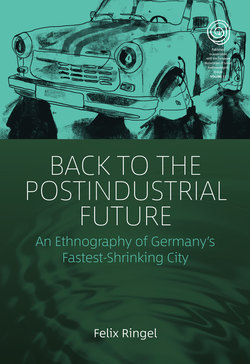Читать книгу Back to the Postindustrial Future - Felix Ringel - Страница 21
На сайте Литреса книга снята с продажи.
1 ‘There Can Only Be One Narrative’
ОглавлениеPostsocialism, Shrinkage and the Politics of Context in Hoyerswerda
I, as a political person, can change my politics
by … shifting my spatiotemporal horizon.
—David Harvey, Spaces of Hope
Demographic knowledge is powerful, particularly when it refers to the future in something that the title of this book describes as postindustrial times. During my fieldwork in 2008 and 2009, the demographic future of Hoyerswerda looked devastating: although the city had already lost more than half of its population over the previous twenty years, many of its citizens where expecting yet another wave of shrinkage in the years to come. Hoyerswerda’s population had reached one of the highest age-averages of all German cities, so what would happen, as a friend put it, once ‘all of these old people started to die’ (wenn die auch alle anfangen zu sterben)? Indeed, in the long run, there was no end in sight to the city’s demise, and dystopian narratives of decline were widely communicated in local, regional and national media. They had an impact on local thought about life and future prospects, but they did not take away people’s agency. As I claimed in the Introduction, the response to this kind of knowledge about the future and my informants’ everyday experiences of decline was not simply despair or lethargy. Rather, it sparked the production of new kinds of knowledge, deployed to make sense of the city’s problematic present and its unpromising future. Given the undeniably dramatic challenges ahead, such knowledge was in constant need for the right kind of midrange social metaphysics; in order to make (renewed) sense, it needed a context or narrative to fit in.
This chapter tracks the vast variety of contexts and narratives, in and through which my informants made sense of the problems and changes they faced. In its first half, I assemble a collage of short ethnographic examples in order to account for the local diversity and heterogeneity of such contexts. Instead of providing more ethnographic detail about the city’s demise, I focus, still ethnographically, on its inhabitants’ epistemic and conceptual responses to this demise. In its second half, I follow more closely what came to fruition during my time in Hoyerswerda – the emergence, establishment and final acceptance of one particular context: that of shrinkage. This chapter therefore pays tribute to the local diversity of expressions of epistemic or conceptual agency, and follows the contested social production of a context in an economy of knowledge one could rightly describe as ‘inchoate’ (Carrithers 2007), ‘unstable’ (Greenhouse et al. 2002), and characterized by a ‘loss of coherence’ (Lakoff and Collier 2004: 422) and a ‘crisis in meaning’ (Ferguson 1999: 14). It also constantly reflects upon potential academic contexts, which might and might not correspond with local ones. In lieu of a ‘normal’ first chapter, which would introduce the field through accounts of local history and geography, I offer an initial analysis of Hoyerswerda’s local economy of knowledge and ask which context is the best for this book to account for Hoyerswerda’s present.
However, as an epistemic tool, any context is simultaneously restricting and enabling, both for my informants and for me. A particular spatiotemporal context allows for a specific vision of the future, and has its specific repercussions on understanding one’s and others’ (temporal) agency. It affects what local inhabitants as well as external analysts can subject to thought and how they do it. This explains the clashes and conflicts that arise when different ideas about the city’s present collide. However, despite local contextual diversity and my own methodological interventions in search of a better or more promising context, the factual results of shrinkage and outmigration seem all too inevitable. Indeed, in times of postindustrial decline, one has to ask whether, after all, there can only be one narrative. The first ethnographic example of an art project in, and slightly out of, context will help me to expand on this question. It offers, for a start, a somewhat external perspective on the city’s past, present and future.
Figure 1.1 ‘ONE NARRATIVE’: ‘ArtBlock’ building, WK 10, Hoyerswerda Neustadt, August 2008
